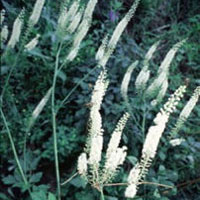Penn Herb Wellness Guide
Black CohoshFind Products
 © Steven Foster
© Steven FosterParts Used & Where Grown
Black cohosh is a shrub-like plant native to the eastern deciduous forests of North America, ranging from southern Ontario to Georgia, north to Wisconsin and west to Arkansas. The dried root and rhizome are used medicinally.1 When harvested from the wild, the root is black in color. Cohosh, an Algonquin Indian word meaning “rough,” refers to the plants gnarly root structure.2
- Reliable and relatively consistent scientific data showing a substantial health benefit.
- Contradictory, insufficient, or preliminary studies suggesting a health benefit or minimal health benefit.
- For an herb, supported by traditional use but minimal or no scientific evidence. For a supplement,little scientific support.
Our proprietary “Star-Rating” system was developed to help you easily understand the amount of scientific support behind each supplement in relation to a specific health condition. While there is no way to predict whether a vitamin, mineral, or herb will successfully treat or prevent associated health conditions, our unique ratings tell you how well these supplements are understood by the medical community, and whether studies have found them to be effective for other people.
For over a decade, our team has combed through thousands of research articles published in reputable journals. To help you make educated decisions, and to better understand controversial or confusing supplements, our medical experts have digested the science into these three easy-to-follow ratings. We hope this provides you with a helpful resource to make informed decisions towards your health and well-being.
This supplement has been used in connection with the following health conditions:
| Used for | Amount | Why |
|---|---|---|
Menopause | 20 mg of a highly concentrated herbal extract taken twice per day | Studies have shown black cohosh to be a safe and effective treatment for women with hot flashes associated with menopause. |
Menopause and Depression (St. John’s Wort) | Two tablets twice a day for 8 weeks, then one tablet twice a day for 8 weeks, each tablet supplying 1 mg of triterpene glycosides from black cohosh and 0.25 mg of hypericin from St. John's wort | Menopausal and depression symptoms improved in post-menopausal women afterthey took acombination of black cohosh and St. John's wort.
|
Dysmenorrhea | Refer to label instructions | Black cohosh has a history as a folk medicine for relieving menstrual cramps. |
Osteoporosis | Refer to label instructions | Black cohosh has been shown to improve bone mineral density in animals fed a low-calcium diet. |
Premenstrual Syndrome | Refer to label instructions | Black cohosh has been historically used to treat PMS. |
Traditional Use (May Not Be Supported by Scientific Studies)
Native Americans valued the herb and used it for many conditions, ranging from gynecological problems to rattlesnake bites. Some 19th century American physicians used black cohosh for fever, menstrual cramps, arthritis, and insomnia.3
Copyright 2025 TraceGains, Inc. All rights reserved.
Learn more about TraceGains, the company.
The information presented by TraceGains is for informational purposes only. It is based on scientific studies (human, animal, or in vitro), clinical experience, or traditional usage as cited in each article. The results reported may not necessarily occur in all individuals. Self-treatment is not recommended for life-threatening conditions that require medical treatment under a doctor's care. For many of the conditions discussed, treatment with prescription or over the counter medication is also available. Consult your doctor, practitioner, and/or pharmacist for any health problem and before using any supplements or before making any changes in prescribed medications. Information expires December 2025.


